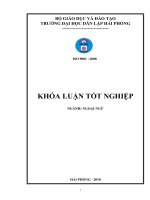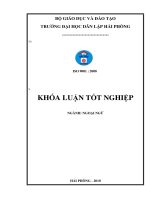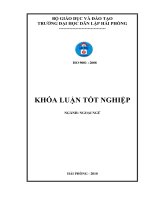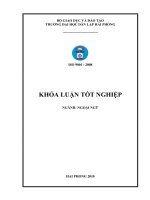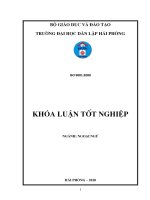A STUDY ON ENGLISH TWO – WORD VERBS
Bạn đang xem bản rút gọn của tài liệu. Xem và tải ngay bản đầy đủ của tài liệu tại đây (135.77 KB, 15 trang )
VIETNAM NATIONAL UNIVERSITY, HANOI
UNIVERSITY OF LANGUAGES AND INTERNATIONAL STUDIES
DEPARTMENT OF POST- GRADUATE
Semantics
End-of-term Assignment
A STUDY ON
ENGLISH TWO –
WORD VERBS
Lecturer: Dr. Hà Cẩm Tâm
Student:Dao Thi Sang
Group: K18C
Hanoi, June 2010
Acknowledgement
I would like to express my gratitude to Dr Ha Cam Tam, my supervisor for her
enthusiastic guidance throughout my semantics course as well as her suggestions
for semantics topics.
My special thanks also go to my friends and classmates who have been with me
during the MA course for their encouragement.
Finally my heart- felt gratitude goes to my family especially my mother for their
help and encouragement during the course.
2
Tables of content
Acknowledgement
Tables of content
Chapter 1: Introduction
1.1. Rationale
1.2. Aims of the study
1.3. Scope of the study
Chapter 2: Development
2.1. Theoretical background
2.1.1. An overview of two – word verbs in English
2.1.1.1. Definition
2.1.1.2. Classifications and characteristics of two- word verbs in English
2.1.1.2.1. Phrasal verbs
2.1.1.2.2. Prepositional verbs
2.1.1.2.3. Phrasal – prepositional verbs
2.2. Some implications for teaching English two – word verbs to Vietnamese
learners
Chapter 3: Conclusion
References
3
Chapter 1: Introduction
1.1. Rationale
It is a fact that more and more people learn English for different reasons. Many
people learn English easily but others have encountered many difficulties
mastering the language because of great deal of linguistic differences between
the Vietnamese and English people. And also the differences in culture, ways of
thinking, lifestyle etc. The learners have faced many problems in learning
English especially when they learned two- word verbs and simultaneously
made a great deal of errors in using them. Two- word verbs are considered to be
one of the most difficult for learners of English because they have various
meanings and sometimes it is very difficult to guess the meanings of these verbs.
Generally those verbs are so numerous, so various and so difficulties that
learners very often tend to avoid using them as far as possible.
Under those circumstances, in this assignment an attempt has been made to
review the two- word verbs of English. Consequently, my final semantic
assignment is entitled “A study on English two- word verbs”
1.2. Aims of the study
The aims of this assignment are:
- To give a background of two – word English verbs
- To give some teaching implications for teaching and learning two- word
English verbs
1.3. Scope of the study
Murphy (1983) states that two- word verbs add a great to the force, colour and
flexibility of the English language and, if a learner’s vocabulary and use of
English is not always to appear “foreign”, it is essential that he or she masters a
large number of these verbs. However, as discussed above two- word verbs are
numerous, various and difficult so it would be too ambitious for me to cover all
4
aspects of English two word verbs. This is the reason why in this assignment, I
only focus on reviewing English two word verbs.
5
Chapter 2: Development
2.1. Theoretical background
2.1.1. An overview of two – word verbs in English
Learners of English often identify two- word verbs as one of the most important
and difficult features of English. A lot of them often fail to understand the
meaning of two – word verbs whenever they can and they consider this to be a
thoroughly reasonable “coping strategy” that other people should respect. Other
learners may welcome help and encouragement to use what they have learned.
Some learners find it helpful to analyze the form of two- word verbs and to
classify them under syntactic or semantic types. Others refer to learn them as
individual items of vocabulary. From this fact, an overview of two- word verbs
is examined in this chapter partially to help all the learners get general ideas
about this kind of verbs to be confident enough to use them.
2.1.1.1. Definition
According to Alexander (1988:152) and Seidl (1990:7), one of the most
common characteristics of the English verbs is that they can combine with
prepositions and adverbs particles. Broadly speaking, in this paper, we call these
combinations two – word verbs to describe any commonly- used combination of
verb + preposition or verb + adverb particle.
Parrot (2000:108) and Richards (1992), in narrow view, state that two- word
verbs are made up of a verb (e.g. come, get, give, look) and one particle, one
preposition or one particle and one preposition to make combinations. For
example: come across, give up ( V+ particle); look after ( V+ preposition); get
on with ( V + particle + preposition).
The combination is essential to the use of the verb. For example, the verb listen,
(which can occur on its own in e.g. Listen!) must be followed by to when it
has an object like
in
“ she likes listening to pop music”. However, the
combination is sometimes not essential but reinforces the meaning of a verb, for
6
example the verb drink, in Drink your milk! can be reinforced by up to suggest “
finish drinking it” or “ drink it all”
Beaumont and Granger (1989:281), from their semantic point of view, define
that two- word verbs are verbs which change their meaning in some way by
adding particles.
For example, the verb look can combine with a large number of prepositions or
particles to form new verbs: look after (= take care of), look down on ( = regard
someone/ something as inferior), look into (= investigate), look out (= be
careful), etc. Also, a single combination can have different meanings, depending
on the words which accompany it, i.e. “Collocations”. Here are some of the
collocations and meaning of take off:
The plane took off.
The boy/ thief (persons or animals) took off.
The sales took off.
2.1.1.2. Classifications and characteristics of two- word verbs in English
According to Seidl (1990), there are three basic combinations of verb, adverb
particles and preposition. These combinations have the structures as followed:
Verb + particle = phrasal verbs
Verb + preposition = prepositional verb ( Vprep)
verb + particle + preposition = phrasal – prepositional verbs ( V phr. prep)
John called up the man. ( Vphr)
John called on the man. ( V prep)
John put up with the man. ( V phr.prep)
(Quirk 1972: 811)
Each of the groups of verbs has its own characteristics that teachers and learners
of English are supposed to bear in mind to distinguish and to use them correctly.
2.1.1.2.1. Phrasal verbs
7
According to G.Leech (1992 :1993), phrasal verbs are all the verbs which are
made of the combination of a verb and an adverb particle.
They are standing up near the window.
When I touched him on the shoulder he turned round.
These verbs have the structure:
Phrasal verbs = verb + Particle ( V + Part)
Sometimes phrasal verbs are used non- idiomatically. This means the meaning
of the verbs is the combination of the two words used: e.g. come + out ( i.e. it is
the same as the meaning of its separate parts.) The verb and the particle keep
their individual lexical meanings so the meaning of its separate parts so the
meaning of these verbs is often deducible from their parts, for example, find
out ( discover), look over ( inspect). However, sometimes, a combination of verb
+ particle results in a separate unit of meaning which idiomatic or highly
idiomatic. The total meaning of the combination may bear no relationship to the
meaning of the individual words combined. Those verbs have a special meaning
which cannot be easily guessed from the meaning of separate words. For
instance, the non- idiomatic meaning of fall through is clear in the sentence:
“The ice was thin and Jimmy fell through” i.e. he fell through the ice into water.(
Seidl, 1990:7). nevertheless, in the sentence “ Sue had plans to go to Africa, but
they fell through the meaning of fall though is “ fail”. And any combination may
have several idiomatic meanings depending on the words around it. Take the
verb put and the particle out as an example:
Put out your cigarettes. ( = extinguish)
We put out a request for volunteers. ( issued)
They’re putting the programme out tomorrow. ( = broadcasting)
This stuff will put
you out in no time. ( = make you unconscious)
Martha’s put out her
hip again. ( = dislocated) ( Alexandra, 1988:153)
8
Basing on the types of complementation, phrasal verbs are put into two
groups, transitive and intransitive phrasal verbs. Transitive phrasal verbs are
those that take a direct object while intransitive phrasal verbs can not be
follow by an object. They have the structures as follows:
Transitive
phrasal verb = verb + direct object + particle
Transitive phrasal verb = verb + particle + direct object
Intransitive phrasal verb = verb + particle
Most of transitive verbs are separable, this means the particle of the verb can be
separated from its verb. It can either precede or go immediately after the direct
object.
(a) She packed her job in.
(b) She packed in her job.
When the noun phrase is long (as a guideline four words or more), choice ( b) is
preferable so that the particle is not placed too far away from the verb.
She packed a well – paid job that was well – paid but stressful. However, the
particle cannot precede pronouns ( him, me, her, etc) as a direct object
She brought six boys up or She brought up six boys.
But she brought them up not she brought up them. ( Seidle, 1990:20)
Transitive can be seen in their acceptance of passivization, whereas passive
constructions are impossible with intransitive verbs because they do not take an
object.
All the lights in the house have been turned off ( Alexander, 1988:156)
Besides, transitive phrasal verbs can be used with
questions
with the
pronominal form with who(m) for people and with what for things.
Whom did you call up?
What did John look for?
( Quirk, 1972:813)
9
Both transitive and intransitive verbs can be formed into nouns with questions
with ..e.g. a climb- down , a dropout, an outbreak, an onlooker, etc. ( Alexander,
1988: 175)
I’ve never heard such a carry- on.
When there is an adverb in the sentence with a phrasal verb, the adverb cannot
be placed between verb and particle. “ I looked eagerly up the road. ( Chalker,
1984:233)
Next, some combinations of this group can be used transitively or intransitively
without a difference of meaning. (Quirk, 1973: 348) Drink up quickly!
( intransitive) and Drink up your milk quickly. (Transitive), or they can be
transitive with one meaning: We have to turn out our essay in/turn in our essays
by Friday, and intransitive with another meaning: I feel sleepy, so I think I’ll
turn in. (= go to bed)
An additional characteristic is about the phonological one. The particle of the
verb is stressed when it comes at the end of the sentence or when the direct
object is a pronoun.
He took off his coat.
What time did the flight eventually take off?
He took him off beautifully. ( = imitate)
In other cases, especially when an adverbs follows the phrasal verb, the usual
rules for sentence stress apply:
The lorry lowed down immediately.
The flight took off later than scheduled. ( Seidl, 1990: 11)
What is more, the particles of these verbs sometimes can strengthen the effect of
the verb as in, Write down their names; hurry up/ or extend the meaning of a
verb,e.g. Give out these leaflets. (= distribute). In some cases, the particle can be
omitted like Write their names: Hurry!
2.1.1.2.2. Prepositional verbs
Prepositional verbs are the combinations of a verb and a particle which functions
as a preposition which takes an object.
10
Sometimes, it is very difficult for learners of English to distinguish prepositional
verbs and prepositional phrases. Let’s take the sentence “ He looked at the girl”
into consideration. This sentence can be given two analyses. In one, there is an
intransitive verb “ looked” followed by a prepositional verbs “ looked” is
transitive with ( the girl) as prepositional object. The two analyses can be
regarded as different but equally valid ways of looking at the same structure.
The particles of the prepositional verbs cannot be separated from the verbs.
She looks after it carefully.
However, the separation is sometimes possible in relative clauses and questions
The picture at which you are looking was bought at an auction.
At which pictures are you looking?
2.1.1.2.3. Phrasal – prepositional verbs
Phrasal – prepositional verbs are the combinations of a verb with two particles.
The first particle is classified as an adverbs and the second as a preposition and
the particles are inseparable.
You should look up to teachers. ( = respect)
not: You should look up teachers to.
The verbs of this group are transitive and must therefore be followed by an
object.
I don’t know how you put up with these conditions. (Alexander, 1988: 158)
Some verbs can go into the passive but others cannot.
All the old regulations were done away with.
I find it difficult to keep up with you.
Adverbs cannot be inserted immediately before the object of these verbs but can
be placed between the particles.
He puts up with willingly that secretary of his.
He puts up willingly with that secretary of his. ( Quirk, 1973:351)
In relative clauses and questions, the particles positioned after the verbs.
The party we were looking forward to so early.
With whom does he put up with willingly?
11
Some of these verbs can form two – word nouns: e.g. Come down from, drive
on to, hurry over to, run along to, stay away from, walk up to, etc or they vary
in their idiomatically like: put up with ( tolerate), run out of ( use up). With these
verbs we cannot choose the preposition to use after the particle. Each verb
conveys a single, indivisible meaning.
The stress of phrasal – phrasal – prepositional verbs often falls on the particle
when the verb is in isolation or when the object is a pronoun. “Who put Jim up
to it?” When the object is a noun, the stress applied as followed “Who put Jim
up to telling “lies”?
In summary, English two – word verbs have been described and classified into
phrasal verbs, prepositional verbs and phrasal prepositional verbs with their
own syntactical, semantic- structural and phonological features.
2.2. Some implications for teaching English two – word verbs to Vietnamese
learners
One of the essential thing is when materials for phrasal verbs are put forward, a
great attention should be paid to the difficulty levels: the lowest difficulty level,
normal difficulty level and the most difficult level. Highly idiomatic phrasal
verbs in the early process of learning English phrasal verbs may confuse
intermediate students.
Once learners have acquired certain phrasal verbs, we should encourage them to
practise using them as much as they can in their speech and writing. (Although
phrasal verbs are marked as colloquial, they can still use in writing depending on
what we wish to say, how we wish to say and to whom we wish to say.)
With the aim of enabling the learners to comprehend and correctly use two word
verbs, the teacher, when introducing any case, should provide examples as
illustrations. For example, when distinguish the difference between transitive
phrasal verbs and prepositional verbs, the following example may be given:
(1)They called on the man. (V + prep + NP)
(2) They called up the man. (V + Part + NP)
Sentence (2) can be expressed in two different ways:
12
They called the man up. Or They called him up.
Whereas the sentence (1) can be only changed in one way
They called on him.
Not “They called the man on” nor “ they called him on”
Besides, the teacher should help develop the learners’ ability to guess the
meaning of a two – word verbs in a certain context so that they can master the
verb quickly by themselves.
For example:
He picked the paper on the ground up.
He went to the airport to pick his friend up.
He went to the travel agent to pick up the ticket.
13
Chapter 3: Conclusion
In conclusion, English two- word verbs instruct learners in an aspect of English
that is especially difficult for learners of English as a second language. However,
these verbs add a great deal to the force, color and flexibility of the English
language. Therefore, learners should have a greater understanding of English
two words and their uses. It is for this reason that my efforts are made.
This study is conducted based on the theoretical foundation of the overview of
English two- word verbs. Realizing English two word verbs in two typesidiomatic phrasal and non- idiomatic phrasal verbs, is of great importance in the
process of teaching and learning two- word verbs. From it, learners can find out
their own effective learning strategy of phrasal verbs. And obviously, learners
who have a greater understanding of common English phrasal verbs can
improve English in all language skills.
I think that the assignment is still modest. However, I hope that this research
work is beneficial in some way to Vietnamese teachers and learners and to those
who are interested in teaching English two – word verbs.
14
References
1. Alexander, LG. 1988. Longman English Grammar, p.p. 152- 158.
Longman House, London and New York
2. Beaumont,digby& Granger, Colin.1989. The Heinemann English
Grammar, p.p.281-284. Heinemnann Publlishers. Oxford Ltd.
3. Chalker, S.1984. Current English Grammar. Macmillan publisher Ltd,
London & Basingstoke.
4. Cowie, AP and Mackin, R 1993. Oxford Dictionary of Phrasal Verbs.
Oxford University Press.
5. Cullen, K, Sargean. H. 1998. Dictionary of Phrasal verbs. Champ
English.
6. Eastwood, John. 1992. Oxford Practice Grammar. Oxford University
press.
7. Hook, J.N. Two- word verbs in English. Harcourt Brace Jonavovich,
publishers.
8. Murphy, R .1994 . English grammar in Use. Cambridge University press
9. Murphy, M.J. 1983. Understanding Phrasal verbs. Hulton Educational.
10.Seidle, Jenifer. 1990. Exercises on phrasal verbs .Oxford University
press
15
